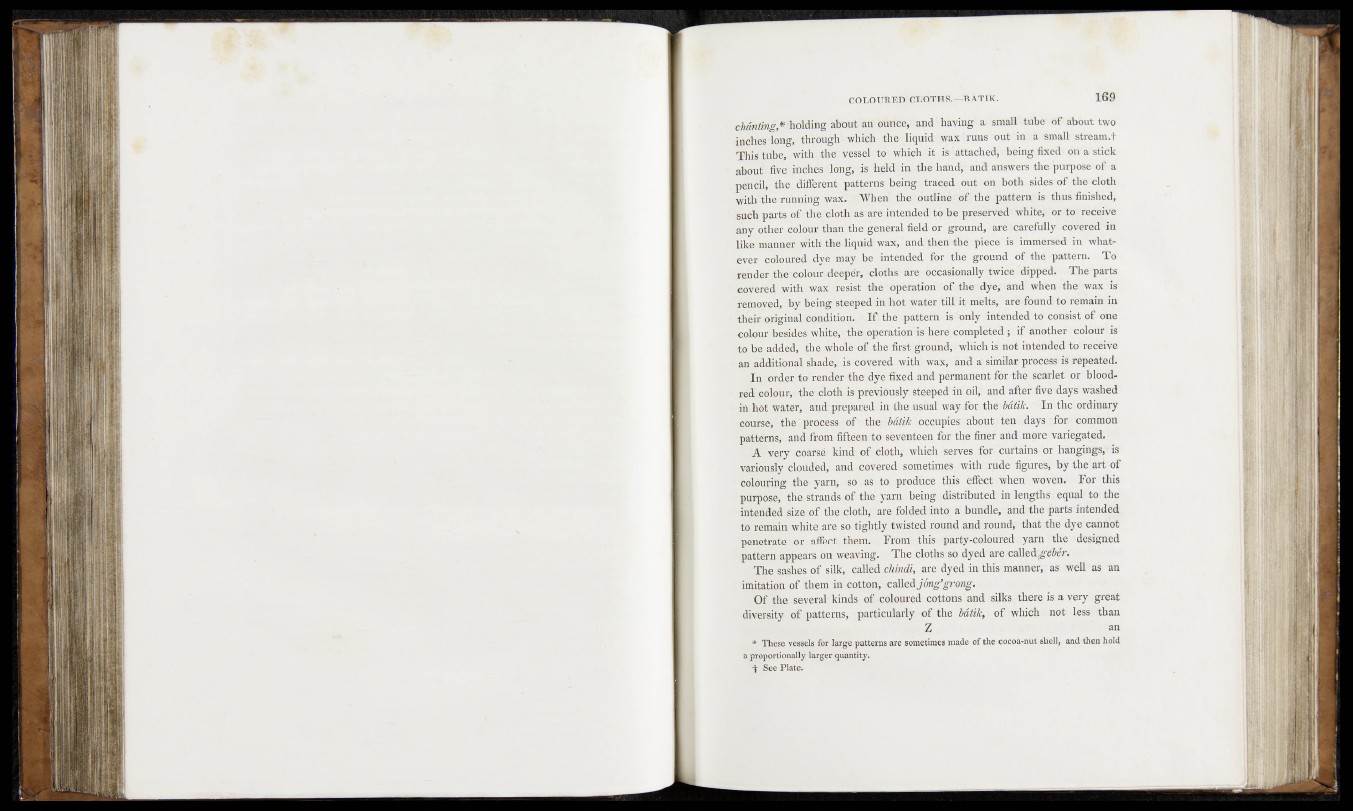
cte^,^oWdng.^b%R^^b^Jfcei':atid!jtaVingf'a ismall'dabe? of about two
dfoehes "long, ttHipdjghbwhicH the^lltjtridowax Bruns'?out in’'a small stream.t
Thktufee,-:withi the“ vessel,'to'. ’tahieh'-it as^attached,'/being -fixed?» bna stick
about'il^fi^ircb^ldbgr’is' held:in ^ ^ ^ ^ 4^mTi'sW'ets the-'ptfrpose''o& a
pencill^fevdTff^Mt,-!. patterns b®2vgNi-trac,edi oi^f; on .both sid-g^&f the cloth
withfhe running. iwaxjj oiWhent the^(|fljtlinei>o‘fi''the pattern is^tfeus finished,
such parts' oft the' 'clqth^as farefMbfidedt ^oShb?pi,^eWe!db whiter or to recede
B Se?‘e^ f e ^ o r groupd, tare't carefully' coVeredtin
likeimauner; with’ t-he'Jiquidi wax,\ndfth;er^h4ipiecevfis immersed in what-
Bpir coloured, dye-piay; ,,be-didenjed for the gijo.und^Ojffyih.#-pattern. To>
^tehd erihetcolour deeper,-'.cloths' are'KbccaSionaily ^twioe .'dipped. >< The parts
tasered' witHii1waxiffesi-^E-.-the'tdperatibn,i ofetheT.dye, -and when dhej wax is
by, feeing' steeped dn^ho^ejwaiser till? itwblts^aiel'fban^to 'refnaia in
their pEiginal^eopditibiB^ -^IfttbeJ pattern is'v©n?ly intended*t<r<onl5ist ,of {tfn‘e
eolour^besides'white,‘ji.the loperationiis here^completed“;-*if another teolour'is
ito b&addp^ the^h o le of the-firsti^rpund, ^Ihchllsbnbt'inteAded^.to^receive
anr additional slip|fei(;4s covered with! wax, -and aisiMM'E-prbcesslisVrepea'ted.
In nrderlto render-the dyejfixed/and'per-manent fortheU'Gasd'etii'OE blood-
red, colpuiy th& cloth -is previously sfe’eped^n^di^ and after- five<day^-washed
tnjti'ot, -Water, and prepared in the usual way* foi^tYieibaiik. Inkhetardinary
r cnijTisftr—the process* of th e t batik 'occupies? about A&itfdays<^^^;oamion
paitterns, and'from fifteen to^^enteen^oipthe'vffeei and 'mbre variegated,'1 •5
A -qoarse1 kind ofr» e-lotly which 'secvesjpfdcuAainS or hangings,«-is
variously clouded, :airidr 'covered sometimes with, rude tfighre^'.b^-iihetart of
colouring the- yarn, -so as to produce this effect -whep^woven. For 'this
purpose, ithe^strands of- the yarn being .distributed in lengths i. equal' to the
intended-’size-of the cloth,are folded-into a bundle, and’the,-parts intended,
to remain white* are. s® tightly, >twisted round andround/’that- the'dye cannot
penetrate'or affect than-.' From. ‘.this- ;party-coloured 'yarn ‘^Ke-ude$ighed
pattern appears on weaving* h'The.bloithscso dyedrarencall’ed'^e&ifr.
The sashes of silk, called cJandi, are dyed imihis manner, " as .well* as 'an
imitation of th em called
Of the several kinds; ofypblp.ured cottons and-silks, there is a very great
diversity of patterns, • particularly;-pMhe batik, of' which not less ithan
Z an
* These vessels for large patterns are sometimes made o f the cocoa-nut shell, and then1 hold
a proportionally larger quantity,
d .See Plate.